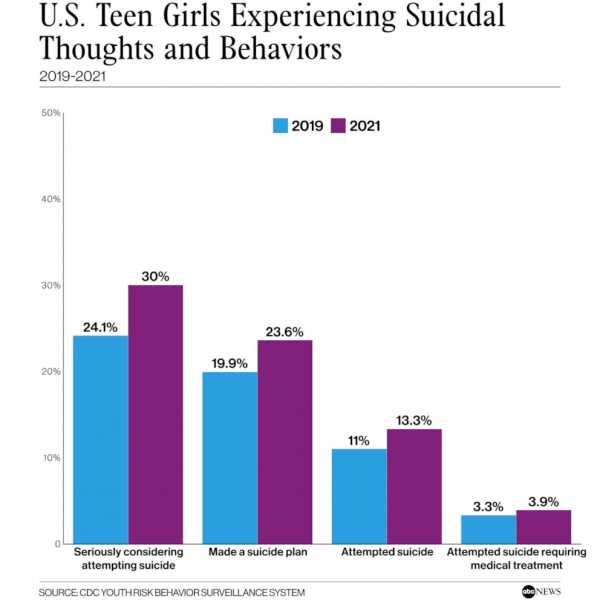The number of teenage girls experiencing suicidal thoughts and behaviors increased during the second year of the pandemic, new federal data showed.
The percentage of high school female students who seriously considered attempting suicide rose from 24.1% to about one-third, or 30%, between 2019 and 2021, according to the latest results of the Youth Risk Behavior Survey, published Thursday by the Centers for Disease Control and Prevention.
The percentage of those who made a suicide plan increased from 19.9% to 23.6% and there was also an increase in suicide attempts from 11.0% to 13.3%, according to the CDC survey.
Differences were seen when it came to students' ages, race/ethnicity or gender identity.
MORE: A child psychiatrist breaks down Biden's youth mental health priorities: Analysis
For example, 9th and 10th-grade girls were more likely to seriously consider attempting suicide than 12th-grade girls.
Ninth graders who were seriously considering suicide increased from 23.7% in 2019 to 30.7% in 2021 and 10th graders saw an increase from 23.6% to 33.6% over the same period. However, for 12th-grade girls, the risk went up from 24.0% in 2019 to 25.6% in 2021.
Freshman and sophomore high school girls were also more likely to make a suicide plan and attempt suicide compared to senior high school girls, according to the CDC.

US Teen Girls Experiencing Suicidal Thoughts and BehaviorsCDC Youth Risk Behavior Surveillance System
"Because of the increased prevalence of suicidal thoughts and behaviors among female students, particularly for those in 9th- and 10th-grade, the importance of early prevention and intervention to prevent suicide is evident," the authors wrote.
In 2021, Black students were nearly 1.5 times more likely than white female students to report having attempted suicide.
Compared to white female students, Hispanic female students had increased rates of suicide attempts requiring medical attention.
Additionally, LGBQ+ students had higher rates of reporting attempted suicide than heterosexual students, the CDC said.
Those identifying as lesbian or gay were found to have nearly 1.9 times higher rates, identifying as bisexual nearly 3.3 times higher rates, and identifying as questioning 1.5 times higher rates compared to heterosexual students.
Meanwhile, when it came to suicidal thoughts and behaviors among male students, percentages were relatively stable between 2019 and 2021.
MORE: ABC News special explores mental health crisis among youth amid COVID-19
The Youth Risk Behavior Survey is conducted every other year and surveys thousands of high school-age children from public and private schools between grades 9 and 12 across all 50 states and the District of Columbia.
Although suicide is the 11th leading cause of death overall in the United States, it is the third among U.S. high school students between the ages 14 and 18, accounting for one-fifth of all deaths among this age group, the report said.
The authors said the findings in the report are consistent with trends before the COVID-19 pandemic, but the rising rates of suicide risk among teen girls may be linked to how measures, such as social distancing and remote learning, may have increased students' social isolation and anxiety.
Common risk factors for suicide include a history of depression and other mental illness, bullying, loss of relationships, and social isolation, according to the CDC.

This undated stock photo shows a young woman sitting alone and covering her face with her hands.STOCK PHOTO/Getty Images
The CDC team added that understanding why rates were stable among male students, even during an event such as the pandemic, "could yield insights into protective factors."
"A comprehensive approach to suicide prevention, which reduces risk and supports youths at increased risk, provides support to those at risk and can ultimately save lives," they wrote.
It comes after a report released earlier this year from the CDC showed teen girls were experiencing record-high levels of feelings of sadness and acts of violence.
Nearly three in five — or 57% — of girls reported feeling persistently sad or hopeless in 2021, up from 36% in 2011 and the highest levels seen in the past decade, the data found.
Sourse: abcnews.go.com






